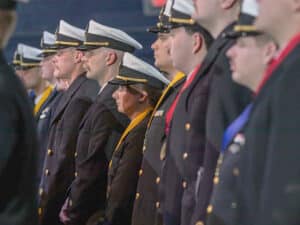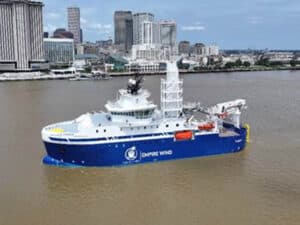
Massport takes delivery of new fireboat
Written by A new RAnger 2400 Class fireboat, American United, has been delivered to the Massachusetts Port Authority, Boston by shipbuilder A.F. Theriault & Son Ltd., of Meteghan River, Nova Scotia, Canada. Designed by Robert Allan Ltd. of Vancouver, B.C., the fireboat will replace Massport’s existing vessel Howard W. Fitzpatrick, built in 1971.
A new RAnger 2400 Class fireboat, American United, has been delivered to the Massachusetts Port Authority, Boston by shipbuilder A.F. Theriault & Son Ltd., of Meteghan River, Nova Scotia, Canada. Designed by Robert Allan Ltd. of Vancouver, B.C., the fireboat will replace Massport’s existing vessel Howard W. Fitzpatrick, built in 1971.

The new high-performance fireboat is specifically designed to provide fast emergency response, search and rescue, fire-fighting operations, capability as an on-scene command post, port security, EMS and assistance with diving operations and recovery. The vessel is of all-welded aluminum construction and is ice-strengthened to suit year-round operations in Boston Harbour and surroundings. The vessel is equipped with a large aft swim platform, and thirty Switlik life rafts to facilitate rescue of aircraft crash survivors. The vessel is also fitted with a FLIR thermal imaging system and ample flood lighting for night time operation.
The vessel has been built in accordance with the ABS Guide for Building and Classing High Speed Craft, but was not so classed, and satisfies the requirements for designation as an NFPA Class III fireboat.
The American United has the following particulars:
Length Overall – 79 ft 1 in (24.10 m) (excluding fenders)
Beam, Molded – 22 ft 2 in (6.76 m)
Depth, Molded – 9 ft 7 in (2.92 m)
Maximum Draft – 7 ft 0 in (2.13 m) (to bottom of props)
The tank capacities are:
Fuel Oil – 1,985 U.S. gallons (7,510 liters)
Fresh Water – 200 U.S. gallons (755 liters)
Fi-Fi Foam – 500 U.S. gallons (1,890 liters)
Black Water – 150 U.S. gallons (565 liters)
Gray Water – 110 U.S. gallons (415 liters)
The fireboat is designed for a full load response speed of 24 knots, which was achieved during trials, and a low-wake, 12 knot cruising/patrol speed. The powering, sea-keeping, and wake generation characteristics of this semi-displacement hull form were verified by computational fluid dynamic analysis (CFD).
The propulsion system consists of four main engines, each driving a fixed-pitch propeller, with the two inboard engines also connected to the two main fire pumps at the forward end. All four engines are utilized to achieve top speed in an emergency response, and then the two inboard engines are de-clutched from the propellers and used to drive the fire pumps while the outboard engines are used to control the boat’s position and heading.
Total installed propulsion power is 2 x 1,450 BHP (2 x 1,080 kW) from two CAT C-32 ACERT engines and 2 x 873 BHP (2 x 650 kW) from two CAT C-18 ACERT engines. Propellers are five bladed, fixed-pitch, driven through ZF models 2000 A and 3050 V reverse-reduction gears on the inboard and outboard shafts respectively. The propeller design was chosen early in the design process for reliable operation in slush ice, which exists at times in the area of operation.
Electrical power is supplied by a pair of CAT C4.4 diesel gensets, each rated 76 ekW.
All engines are EPA Tier II certified.
The Fire-fighting equipment for the RAnger 2400 Class fireboat comprises the following:
Fire pumps: 2 x CounterFire model 250-200-500 pumps, each rated 3,000 U.S. gpm (11,350 l/min) at 150 psi (10 bar), driven off the front of CAT C-18 main engines
Fire monitors:
Wheelhouse top – 1 x Stang 3,000 U.S. gpm (11,350 l/min), remote controlled
Forward – 2 x Stang 1,500 U.S. gpm (2 x 5,680 l/min), manual controls
Deckhouse top aft – 2 x Stang 1,500 gpm (2 x 5,680 l/min), manual controls
Fi-Fi Hydrants:
Forward – 1 x 5 in and 3 x 2 1 /2 in hydrants
Aft – 1 x 5 in and 3 x 2 1/2 in hydrants
In addition, there is a foam injection system which can be directed to any selected monitor. The Fi-Fi system utilizes FRP piping throughout, for its reduced weight and corrosion resistance properties.
The American United has the following features:
Bridge Deck:
- wheelhouse forward: arranged with maximum, all-round visibility, and with overhead viewing windows. Wheelhouse controls consist of a centerline main navigation console, a port side docking station and starboard fi-fi controls.
- A command center is located aft in the wheelhouse with chart table for coordinating on-scene activities with land based resources
Main Deck:
- fire-fighting equipment room: outfitted with shelving to store hoses, fittings, rescue equipment, SCBA air packs, etc. and serving double duty as a medical treatment room, accessed by a 6′ wide stainless steel roll-up door
- crew transport room: comfortable seating area with television and lockers for crew’s gear and PFD storage
- large water level rescue platform for diver access and casualty recovery
- multiple hydrant outlets for water supply to shore systems
- flush-mounted, machinery access/removal flush hatch
- exterior aft controls on main deck
Below Deck:
- crew accommodations outfitted to provide a crew rest area in the event of extended operations
- lavatory facilities
- a spacious engine room with full walking height access to all machinery
- the steering gear flat, in which foam tanks and FM 200 fire suppression system are also located
- 75 HP (55 kW) Wesmar model V2-18, electrically driven bow thruster, for enhanced station-keeping and close quarters maneuvring control
October 11, 2011





Leave a Reply
You must be logged in to post a comment.